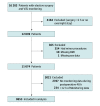Association Between Mobilization and Composite Postoperative Complications Following Major Elective Surgery
- PMID: 37256591
- PMCID: PMC10233451
- DOI: 10.1001/jamasurg.2023.1122
Association Between Mobilization and Composite Postoperative Complications Following Major Elective Surgery
Abstract
Importance: Mobilization after surgery is a key component of Enhanced Recovery after Surgery (ERAS) pathways.
Objective: To evaluate the association between mobilization and a collapsed composite of postoperative complications in patients recovering from major elective surgery as well as hospital length of stay, cumulative pain scores, and 30-day readmission rates.
Design, setting, and participants: This retrospective observational study conducted at a single quaternary US referral center included patients who had elective surgery between February 2017 and October 2020. Mobilization was assessed over the first 48 postoperative hours with wearable accelerometers, and outcomes were assessed throughout hospitalization. Patients who had elective surgery lasting at least 2 hours followed by at least 48 hours of hospitalization were included. A minimum of 12 hours of continuous accelerometer monitoring was required without missing confounding variables or key data. Among 16 203 potential participants, 8653 who met inclusion criteria were included in the final analysis. Data were analyzed from February 2017 to October 2020.
Exposures: Amount of mobilization per hour for 48 postoperative hours.
Outcomes: The primary outcome was a composite of myocardial injury, ileus, stroke, venous thromboembolism, pulmonary complications, and all-cause in-hospital mortality. Secondary outcomes included hospital length of stay, cumulative pain scores, and 30-day readmission.
Results: Of 8653 included patients (mean [SD] age, 57.6 [16.0] years; 4535 [52.4%] female), 633 (7.3%) experienced the primary outcome. Mobilization time was a median (IQR) of 3.9 (1.7-7.8) minutes per monitored hour overall, 3.2 (0.9-7.4) in patients who experienced the primary outcome, and 4.1 (1.8-7.9) in those who did not. There was a significant association between postoperative mobilization and the composite outcome (hazard ratio [HR], 0.75; 95% CI, 0.67-0.84; P < .001) for each 4-minute increase in mobilization. Mobilization was associated with an estimated median reduction in the duration of hospitalization by 0.12 days (95% CI, 0.09-0.15; P < .001) for each 4-minute increase in mobilization. The were no associations between mobilization and pain score or 30-day readmission.
Conclusions and relevance: In this study, mobilization measured by wearable accelerometers was associated with fewer postoperative complications and shorter hospital length of stay.
Conflict of interest statement
Figures
Comment in
-
Mobilization and Composite Postoperative Complications.JAMA Surg. 2023 Aug 1;158(8):831. doi: 10.1001/jamasurg.2023.1128. JAMA Surg. 2023. PMID: 37256595 No abstract available.
-
Mobilization, Just 1 Component of Enhanced Recovery After Surgery.JAMA Surg. 2024 Feb 1;159(2):230-231. doi: 10.1001/jamasurg.2023.5230. JAMA Surg. 2024. PMID: 37938832 No abstract available.
Similar articles
-
Does Augmenting Irradiated Autografts With Free Vascularized Fibula Graft in Patients With Bone Loss From a Malignant Tumor Achieve Union, Function, and Complication Rate Comparably to Patients Without Bone Loss and Augmentation When Reconstructing Intercalary Resections in the Lower Extremity?Clin Orthop Relat Res. 2025 Jun 26. doi: 10.1097/CORR.0000000000003599. Online ahead of print. Clin Orthop Relat Res. 2025. PMID: 40569278
-
Continuous intravenous perioperative lidocaine infusion for postoperative pain and recovery in adults.Cochrane Database Syst Rev. 2018 Jun 4;6(6):CD009642. doi: 10.1002/14651858.CD009642.pub3. Cochrane Database Syst Rev. 2018. PMID: 29864216 Free PMC article.
-
Intravenous magnesium sulphate and sotalol for prevention of atrial fibrillation after coronary artery bypass surgery: a systematic review and economic evaluation.Health Technol Assess. 2008 Jun;12(28):iii-iv, ix-95. doi: 10.3310/hta12280. Health Technol Assess. 2008. PMID: 18547499
-
Limited versus full sternotomy for aortic valve replacement.Cochrane Database Syst Rev. 2017 Apr 10;4(4):CD011793. doi: 10.1002/14651858.CD011793.pub2. Cochrane Database Syst Rev. 2017. Update in: Cochrane Database Syst Rev. 2023 Dec 6;12:CD011793. doi: 10.1002/14651858.CD011793.pub3. PMID: 28394022 Free PMC article. Updated.
-
Sertindole for schizophrenia.Cochrane Database Syst Rev. 2005 Jul 20;2005(3):CD001715. doi: 10.1002/14651858.CD001715.pub2. Cochrane Database Syst Rev. 2005. PMID: 16034864 Free PMC article.
Cited by
-
Evaluation and Prevention of Perioperative Respiratory Failure.J Clin Med. 2024 Aug 27;13(17):5083. doi: 10.3390/jcm13175083. J Clin Med. 2024. PMID: 39274295 Free PMC article. Review.
-
Portable wireless monitoring of vital signs in hospital wards.BJA Educ. 2025 Jul;25(7):265-272. doi: 10.1016/j.bjae.2025.04.004. Epub 2025 May 21. BJA Educ. 2025. PMID: 40575591 Review. No abstract available.
-
Influence of motivational interviewing on postoperative mobilization in the enhanced recovery after surgery (ERAS®) pathway in elective colorectal surgery - a randomized patient-blinded pilot study.Langenbecks Arch Surg. 2024 Apr 22;409(1):134. doi: 10.1007/s00423-024-03321-z. Langenbecks Arch Surg. 2024. PMID: 38644386 Free PMC article. Clinical Trial.
-
Feasibility and usefulness of postoperative mobilization goals in the enhanced recovery after surgery (ERAS®) clinical pathway for elective colorectal surgery.Langenbecks Arch Surg. 2024 Aug 31;409(1):266. doi: 10.1007/s00423-024-03442-5. Langenbecks Arch Surg. 2024. PMID: 39215842 Free PMC article.
-
Using a Quality-Controlled Dataset From ViSi Mobile Monitoring for Analyzing Posture Patterns of Hospitalized Patients: Retrospective Observational Study.JMIR Mhealth Uhealth. 2024 Nov 6;12:e54735. doi: 10.2196/54735. JMIR Mhealth Uhealth. 2024. PMID: 39504135 Free PMC article.
References
MeSH terms
LinkOut - more resources
Full Text Sources
Medical
Miscellaneous


